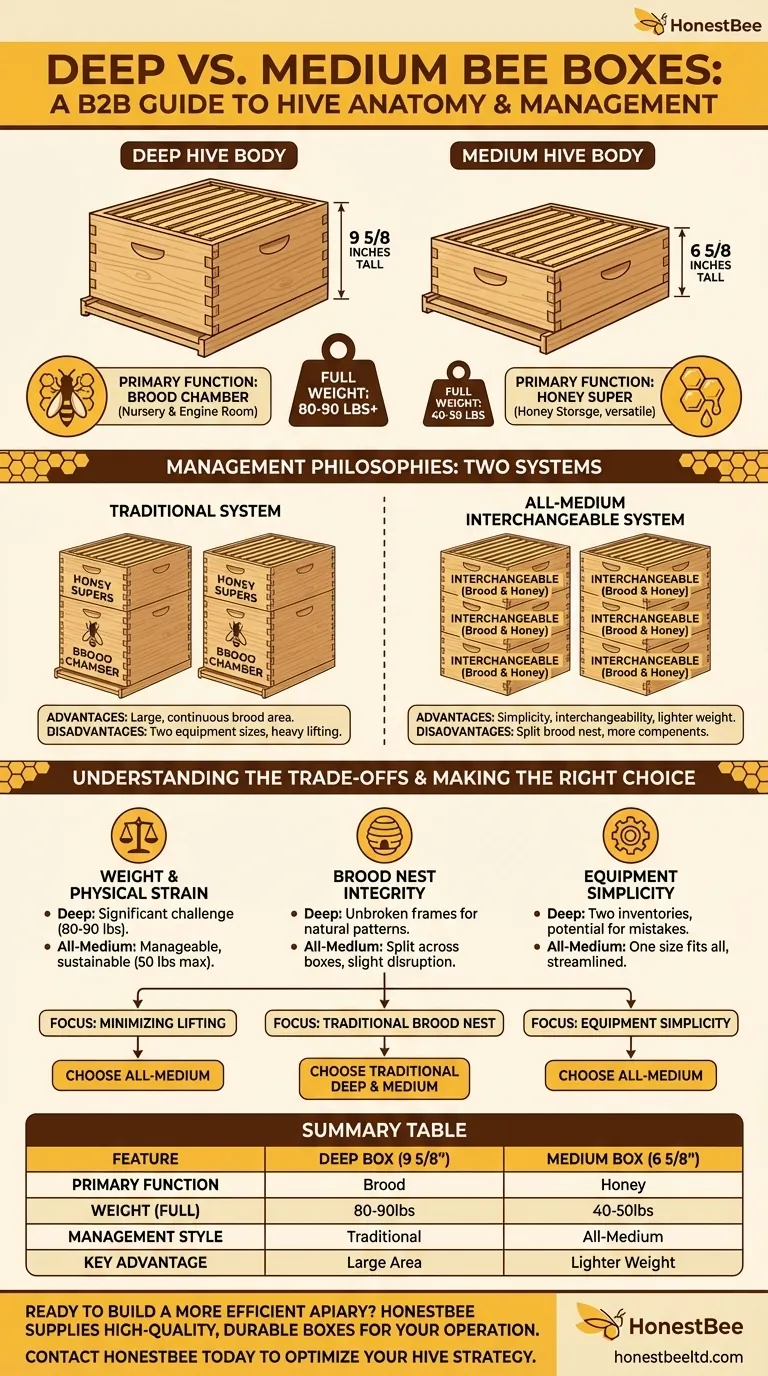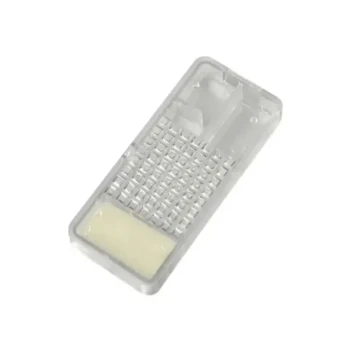The primary difference between a deep and medium bee box is its height, which dictates its weight and intended function within the hive. A standard "deep" Langstroth hive body is 9 5/8 inches tall, designed to house the queen and brood nest. A "medium" super is significantly shorter at 6 5/8 inches and is typically used for honey storage, though it can also be used for brood.
Your choice is not just about equipment size; it's a strategic decision that defines your entire hive management philosophy. Deep boxes favor a larger, less-disturbed brood area at the cost of heavy lifting, while an all-medium setup prioritizes lighter, interchangeable parts at the cost of more components.

The Anatomy of the Hive Box
Understanding the physical specifications of each box is the foundation for deciding which system is right for you. Each dimension serves a specific purpose for the bees and the beekeeper.
The Deep Hive Body (9 5/8 inches)
The deep box is the traditional foundation of a Langstroth hive. Its primary purpose is to serve as the brood chamber—the nursery and engine room of the colony.
The larger frame size provides the queen with a vast, continuous surface for laying eggs. This can encourage a strong, solid brood pattern that is easy to inspect.
However, a deep box filled with honey, pollen, and brood can weigh 80-90 pounds or more. This significant weight is a major factor for beekeepers to consider.
The Medium Hive Body (6 5/8 inches)
The medium box, often called an "Illinois" or "western" super, offers versatility. Its most common use is as a honey super, the box placed above the brood chamber for honey storage.
Because of its smaller size, a medium box filled with honey weighs a much more manageable 40-50 pounds. This makes it a popular choice for honey harvesting.
It can also be used as a brood chamber, though it requires stacking two or even three medium boxes to provide a volume equivalent to a deep brood chamber.
Comparing Management Philosophies
Your choice of box size locks you into a system of management. There are two dominant philosophies, each with distinct advantages.
The "Traditional" Deep Brood Box System
The most common configuration uses one or two deep boxes for the brood chamber at the bottom of the hive. Medium supers are then stacked on top for honey collection.
This setup is thought to better mimic the shape of a colony's nest in a natural cavity, providing a large, vertical space for the queen. It keeps the brood nest largely separate from the honey stores.
The main drawback is that you must manage two different sizes of equipment: deep boxes with deep frames and medium boxes with medium frames.
The "All-Medium" Interchangeable System
This philosophy simplifies operations by using only medium boxes for the entire hive—both brood nest and honey supers.
The primary benefit is simplicity and interchangeability. You only need one size of box and one size of frame. This streamlines equipment purchases, storage, and management.
The significantly lighter weight of each component makes hive inspections and honey harvesting far less physically demanding.
Understanding the Trade-offs
Neither system is universally superior. The right choice depends on a clear-eyed assessment of the trade-offs between bee biology, equipment management, and your own physical capabilities.
Weight and Physical Strain
This is the most critical factor for many beekeepers. Lifting an 80-pound deep box for a hive inspection is a significant physical challenge that can become prohibitive.
An all-medium system completely eliminates this heavy lifting. The heaviest box you will ever need to move is around 50 pounds, making the hobby more accessible and sustainable.
Brood Nest Integrity
Advocates for deep boxes argue that the large, unbroken frames allow the queen to establish a more productive and natural brood pattern.
In an all-medium system, the brood nest is split across the horizontal gaps between two or three boxes. The queen must cross these gaps to continue laying, which some believe can slightly disrupt the nest's cohesion. However, in practice, a strong queen manages this with little issue.
Equipment Simplicity vs. Flexibility
The all-medium system is the clear winner for simplicity. You can move a frame of honey from an upper box down to a lower box to provide food for the brood, as all frames are identical.
The traditional deep-and-medium setup requires you to manage two inventories. A common and frustrating mistake is accidentally placing a medium frame in a deep box (or vice versa), which results in a mess of improperly built comb that must be corrected.
Making the Right Choice for Your Goal
Your ideal hive configuration depends on your physical capabilities, management style, and primary beekeeping goals.
- If your primary focus is minimizing heavy lifting: Choose an all-medium hive configuration from the start, as it makes every aspect of hive management physically easier.
- If your primary focus is creating a large, traditional brood nest: Use one or two deep boxes for the brood chamber and add medium boxes for honey supers.
- If your primary focus is equipment simplicity and interchangeability: An all-medium system is superior, as all boxes and frames are identical and can be used anywhere in the hive.
Ultimately, the best system is the one you can manage consistently and safely, as this will lead to the healthiest bees.
Summary Table:
| Feature | Deep Box (9 5/8") | Medium Box (6 5/8") |
|---|---|---|
| Primary Function | Brood Chamber | Honey Super (can be used for brood) |
| Weight (Full) | 80-90 lbs | 40-50 lbs |
| Management Style | Traditional (Deep Brood + Medium Supers) | All-Medium (Interchangeable) |
| Key Advantage | Large, continuous brood area | Lighter weight, equipment simplicity |
Ready to build a more efficient and manageable apiary?
At HONESTBEE, we supply commercial apiaries and beekeeping equipment distributors with the high-quality, durable deep and medium boxes needed to implement the right system for your operation. Our wholesale-focused operations ensure you get the equipment you need to succeed, whether you prefer the traditional deep-brood setup or the simplicity of an all-medium hive.
Contact HONESTBEE today to discuss your equipment needs and optimize your hive management strategy.
Visual Guide

Related Products
- Australian Langstroth Beehive Boxes for Beekeeping Wholesales
- Langstroth Honey Bee Box Hive Boxes for Different Depths
- Professional Insulated Plastic Bee Hives
- Twin Queen Styrofoam Honey Bee Nucs Mating and Breeding Box
- Portable Bee Mating Hive Boxes Mini Mating Nucs 8 Frames for Queen Rearing
People Also Ask
- Why might a beginner be advised to start with a Langstroth hive? Unlock a Supportive Beekeeping Ecosystem
- What are the sizes of supers available in a standard hive? A Guide to Deep, Medium, and Shallow Boxes
- What are the three types of beehives? Find the Perfect Hive for Your Beekeeping Philosophy
- What is the purpose of reversing brood chambers in the spring? A Proactive Swarm Prevention Strategy
- What are beehive boxes, and what are they used for? The Essential Guide to Hive Components



















